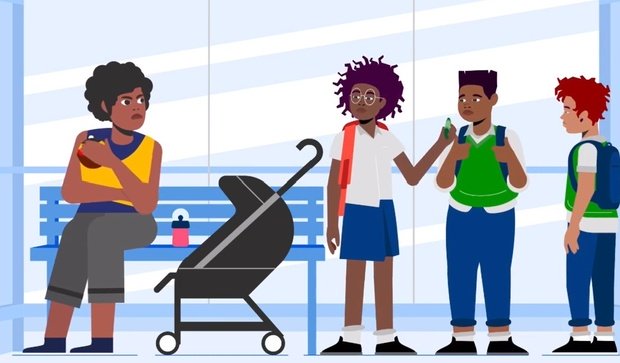Allende is the manager of Na Joomelah, a TIS (Tackling Indigenous Smoking) program aimed at tackling smoking and vaping among Aboriginal and Torres Strait Islander people in Sydney and Wollongong.
Na Joomelah (which translates as ‘no smoking’) helps to facilitate smoke- and vape-free community education and engagement, supports smoke- and vape-free events and assists organisations to implement smoke- and vape-free policies.
“It doesn’t matter who you are, there’s a lot of people vaping, particularly young people,” Allende said.
“We’ve had some pretty scary stories of kids as young as Year 2 being caught with vapes at schools.
“It’s quite scary the amount of people we know are out there vaping but our job is to try and make that change and get our young people to see vaping in a different light.”
A new series of animations, co-designed with Lung Foundation Australia and in consultation with young First Nations people, is starting to help make that change.
After running some youth focus groups, Na Joomelah settled on highlighting not just the health impacts of vaping but two other major topics of keen interest - the environment and sport.
Since then the animations and accompanying fact sheets have been circulating in local schools, youth groups, on Na Joomelah’s social media pages and at community events.
“The stories we’re hearing from young people is that they are listening to the resources, they’re having more of a conversation about what vaping is actually doing to their body as opposed to not caring so much about vaping and seeing it just as the cool thing to do,” Allende said.
“We’ve seen a bit of a shift in mindset about what it is doing, not only to your body but to the environment and potentially to your sporting career.”
Lung Foundation Australia’s policy, advocacy and prevention general manager Paige Preston said even three months after the pilot program, where young people were shown the animations, a third of participants had increased knowledge of the impacts of vaping.
“What that tells us is that this was appropriately designed and together with Na Joomelah we’ve been able to produce something that really does resonate with community, particularly young people,” she said.
“We’re really pleased to see just how impactful these resources were.”
Allende said the success of the videos and accompanying resources is partially due to the involvement of First Nations youth.
“If the kids and young people are involved in the process they’re much more likely to take notice of that message,” he said.
“We could be creating the best resource in terms of educational content but if our kids and young people aren’t interested that’s a waste of time and effort.”
Meanwhile, new modelling from Cancer Council Australia has predicted that nationwide an additional 1185 teenagers aged 12 to 19, would have taken up vaping each week, if Parliament had not passed critical legislation to stop the retail sale of non-therapeutic vapes today.
Public Health Association of Australia, and Lung Foundation Australia had earlier joined Cancer Council Australia in encouraging Parliament to pass the critical Vaping Reforms Bill in the Senate.
The bill, which is expected to be ratified unopposed in the Lower House, will put a firm end date on the manufacture, advertisement, commercial possession and widespread retail sale of any vape outside a pharmacy, essential progress towards driving down vaping rates across all age groups.
Chair of Cancer Council’s Tobacco Issues Committee, Alecia Brooks, said that at least one in six high school students have vaped, and that any potential increase in vaping will have frightening health consequences.
They say knowledge is power & @ShalveyPS senior students got both via a workshop with Na Joomelah around the impact of smoking & vapes. Student engagement was amazing & the Na Joomelah crew were simply brilliant.🧠🤩 #MountDruittMagic🎩 pic.twitter.com/NHPGIzDLcm
— Mark Titheradge (@MindBodySoulNRG) March 23, 2024
“For every week Parliament has waited, the equivalent of an additional school of students has stepped down the path to a future of nicotine addiction and harm,” Brooks said.
“These are students as young as 12, vaping in their first year of high school.
“In just the past year, more than 400,000 teenagers reported vaping at least monthly, if not more. Every one of these teenagers is at greater risk of poisoning, acute nicotine toxicity and lung injury every time they breathe in the toxic chemicals in vapes.”
Vaping among teenagers has risen dramatically as retail sales of vapes have become more common.
While there have been significant amendments negotiated, the legislation presented to Parliament today was considered essential to stopping vapes ending up in the hands of children and young Australians who have never smoked.
Public Health Association of Australia CEO, Adjunct Professor Terry Slevin, said while the bill may not be perfect, “we cannot wait for perfect”.
“The status quo free for all vape market is a disaster for the health of Australians. Every day we delay, more young Australians go down the path of nicotine addiction,” Slevin said.
(with AAP)














